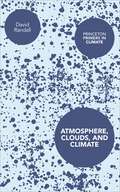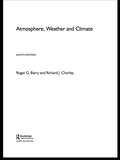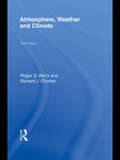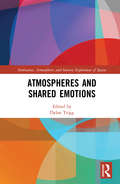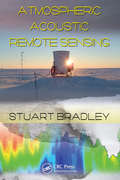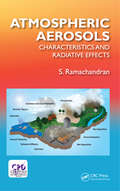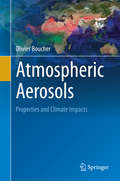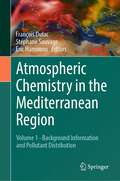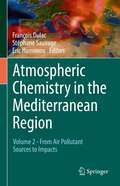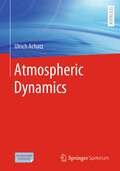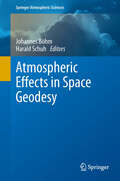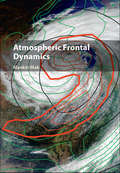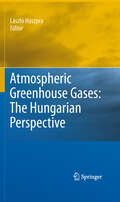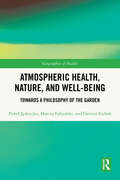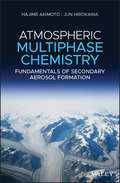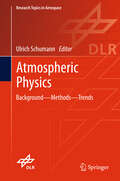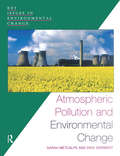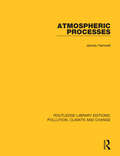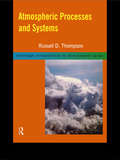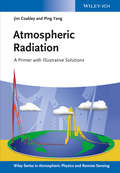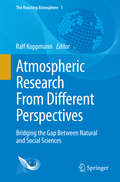- Table View
- List View
Atmosphere, Clouds, and Climate (Princeton Primers in Climate #6)
by David RandallAn essential primer on atmospheric processes and their important role in the climate systemThe atmosphere is critical to climate change. It can amplify shifts in the climate system, and also mitigate them. This primer offers a short, reader-friendly introduction to these atmospheric processes and how they work, written by a leading expert on the subject.Giving readers an overview of key atmospheric processes, David Randall looks at how our climate system receives energy from the sun and sheds it by emitting infrared radiation back into space. The atmosphere regulates these radiative energy flows and transports energy through weather systems such as thunderstorms, monsoons, hurricanes, and winter storms. Randall explains how these processes work, and also how precipitation, cloud formation, and other phase changes of water strongly influence weather and climate. He discusses how atmospheric feedbacks affect climate change, how the large-scale atmospheric circulation works, how predicting the weather and the climate are fundamentally different challenges, and much more. This is the ideal introduction for students and nonspecialists. No prior experience in atmospheric science is needed, only basic college physics.Authoritative and concise, Atmosphere, Clouds, and Climate features a glossary of terms, suggestions for further reading, and easy-to-follow explanations of a few key equations. This accessible primer is the essential introduction to atmospheric processes and the vital role they play in our climate system.
Atmosphere, Weather and Climate
by Roger G. Barry Roger Barry Richard Chorley The late ChorleyFirst Published in 2003. Routledge is an imprint of Taylor & Francis, an informa company.
Atmosphere, Weather and Climate
by Roger G. Barry Richard J ChorleyThis book presents a comprehensive introduction to weather processes and climatic conditions around the world, their observed variability and changes, and projected future trends. Extensively revised and updated, this ninth edition retains its tried and tested structure while incorporating recent advances in the field. From clear explanations of the basic physical and chemical principles of the atmosphere, to descriptions of regional climates and their changes, the book presents a comprehensive coverage of global meteorology and climatology. In this new edition the latest scientific ideas are again expressed in a clear, non-mathematical matter. New features include: extended and updated treatment of atmospheric models final chapter on climate variability and change has been completely rewritten to take account of the IPCC 2007 scientific assessment. new four-colour text design featuring over 30 colour plates over 360 diagrams have been redrawn in full colour to improve clarity and aid understanding. Atmosphere, Weather and Climate continues to be an indispensable source for all those studying the earth’s atmosphere and world climate, whether from environmental and earth sciences, geography, ecology, agriculture, hydrology, or related disciplinary perspectives. Its pedagogic value is enhanced by several features: learning points at the opening of each chapter and discussion topics at their ending, boxes on topical subjects and on twentieth century advances in the field.
Atmospheres and Shared Emotions (Ambiances, Atmospheres and Sensory Experiences of Spaces)
by Dylan TriggThis book explores the role atmospheres play in shared emotion. With insights from leading scholars in the field, Atmospheres and Shared Emotions investigates key issues such as the relation between atmospheres and moods, how atmospheres define psychopathological conditions such as anxiety and schizophrenia, what role atmospheres play in producing shared aesthetic experiences, and the significance of atmospheres in political events. Calling upon disciplinary methodologies as broad as phenomenology, film studies, and law, each of the chapters is thematically connected by a rigorous attention on the multifaceted ways atmosphere play an important role in the development of shared emotion. While the concept of atmosphere has become a critical notion across several disciplines, the relationship between atmospheres and shared emotion remains neglected. The idea of sharing emotion over a particular event is rife within contemporary society. From Brexit to Trump to Covid-19, emotions are not only experienced individually, they are also grasped together. Proceeding from the view that atmospheres can play an explanatory role in accounting for shared emotion, the book promises to make an enduring contribution to both the understanding of atmospheres and to issues in the philosophy of emotion more broadly. Offering both a nuanced analysis of key terms in contemporary debates as well as a series of original studies, the book will be a vital resource for scholars in contemporary philosophy, aesthetics, human geography, and political science.
Atmospheric Acoustic Remote Sensing: Principles and Applications
by Stuart BradleySonic Detection and Ranging (SODAR) systems and Radio Acoustic Sounding Systems (RASS) use sound waves to determine wind speed, wind direction, and turbulent character of the atmosphere. They are increasingly used for environmental and scientific applications such as analyzing ground-level pollution dispersion and monitoring conditions affecting wi
Atmospheric Aerosols: Characteristics and Radiative Effects
by S RamachandranThis book includes basic knowledge and understanding on the characteristics of aerosols over the continent and oceanic regions, their composition, residence times, sinks and size distributions, and their effects in the radiative transfer and climate of Earth.
Atmospheric Aerosols: Properties and Climate Impacts (Springer Atmospheric Sciences)
by Olivier BoucherThis textbook aims to be a one stop shop for those interested in aerosols and their impact on the climate system. It starts with some fundamentals on atmospheric aerosols, atmospheric radiation and cloud physics, then goes into techniques used for in-situ and remote sensing measurements of aerosols, data assimilation, and discusses aerosol-radiation interactions, aerosol-cloud interactions and the multiple impacts of aerosols on the climate system. The book aims to engage those interested in aerosols and their impacts on the climate system: graduate and PhD students, but also post-doctorate fellows who are new to the field or would like to broaden their knowledge. The book includes exercises at the end of most chapters. Atmospheric aerosols are small (microscopic) particles in suspension in the atmosphere, which play multiple roles in the climate system. They interact with the energy budget through scattering and absorption of solar and terrestrial radiation. They also serve as cloud condensation and ice nuclei with impacts on the formation, evolution and properties of clouds. Finally aerosols also interact with some biogeochemical cycles. Anthropogenic emissions of aerosols are responsible for a cooling effect that has masked part of the warming due to the increased greenhouse effect since pre-industrial time. Natural aerosols also respond to climate changes as shown by observations of past climates and modelling of the future climate.
Atmospheric Boundary Layer
by Jordi Vilà-Guerau De Arellano Chiel C. Van Heerwaarden Bart J. H. Van Stratum Kees Van Den DriesBased on more than twenty years of research and lecturing, Jordi Vilà-Guerau de Arellano and his team's textbook provides an excellent introduction to the interactions between the atmosphere and the land for advanced undergraduate and graduate students and a reference text for researchers in atmospheric physics and chemistry, hydrology, and plant physiology. The combination of the book, which provides the essential theoretical concepts, and the associated interactive Chemistry Land-surface Atmosphere Soil Slab (CLASS) software, which provides hands-on practical exercises and allows students to design their own numerical experiments, will prove invaluable for learning about many aspects of the soil-vegetation-atmosphere system. This book has a modular and flexible structure, allowing instructors to accommodate it to their own learning-outcome needs.
Atmospheric Chemistry in the Mediterranean Region: Volume 1 - Background Information and Pollutant Distribution
by François Dulac Stéphane Sauvage Eric HamonouThis two-volume set provides an extensive review of the abundant past and recent literature on the atmospheric chemistry in the Mediterranean region. The books document the experience gained on the atmospheric composition over the Mediterranean basin and close areas after almost six decades of studies, starting from early studies of radioactive aerosol fallouts and intense desert dust events in the 1960s, aerosol samples collected during oceanographic cruises in the early 1980s and including discoveries from subsequent surface monitoring stations, intensive campaigns, satellite climatologies, laboratory studies, as well as chemistry-transport and climate models. Through ten thematic sections, the authors examine the sources and fates of atmospheric pollutants over the Mediterranean basin and what we know about their major impacts on air quality and health, on the radiative budget and climate, on marine chemistry and biogeochemistry. This overview not only considers the full cycle of both aerosol and reactive gases including emissions, transport, transformation, and sinks, but also addresses the main impacts of the regional atmospheric chemistry. The volumes are an initiative from the ending ChArMEx project that has federated many studies on those topics in the past decade, and update the scientific knowledge by integrating the ChArMEx and non-ChArMEx literature. The books are contributed by a large pool of well-known authors from the respective fields, mainly from France and Greece, but also from fourteen other countries. All chapters have been peer-reviewed by international scientific experts in the corresponding domains. Volume 1 provides background information on the Mediterranean atmosphere, and focuses on the synoptic and dynamic conditions affecting pollutant concentrations over the Mediterranean basin, aerosol concentrations and variability, and reactive gas concentrations and variability. The targeted audience is the academic community working on atmospheric chemistry and its impacts on climate, air quality and marine biogeochemistry, especially teams having a special interest in the Mediterranean region, which includes many countries and institutes worldwide.
Atmospheric Chemistry in the Mediterranean Region: Volume 2 - From Air Pollutant Sources to Impacts
by François Dulac Stéphane Sauvage Eric HamonouThis two-volume set provides an extensive review of the abundant past and recent literature on the atmospheric chemistry in the Mediterranean region. The books document the experience gained on the atmospheric composition over the Mediterranean basin and close areas after six decades of research, starting from early studies of radioactive aerosol fallouts and intense desert dust events in the 1960s, followed by studies of aerosols collected during oceanographic cruises in the early 1980s, and including subsequent knowledge from various surface monitoring stations, intensive campaigns, satellite climatologies, laboratory studies, as well as chemistry-transport and climate models. Through ten thematic sections, the authors examine the sources and fates of atmospheric pollutants over the Mediterranean basin and what we know about the main impacts of the regional atmospheric chemistry. This overview not only considers the full regional cycle of both aerosol and reactive gases including emissions, transport, transformations, and sinks, but also addresses their major impacts on air quality and health, on the radiative budget and climate, on marine chemistry and biogeochemistry . The volumes are an initiative from the ChArMEx project that has federated many studies on those topics in the 2010-2020decade, and update the scientific knowledge by integrating the ChArMEx and non-ChArMEx literature. The books are contributed by a large pool of well-known authors from the respective fields, mainly from France and Greece, but also from six other Mediterranean and eight non-Mediterranean countries. All Chapters have been peer-reviewed by international scientific experts in the corresponding domains. Volume 2 focuses on emissions and their sources, recent progress on chemical processes, aerosol properties, atmospheric deposition, and the impacts of air pollution on human health, regional climate and ecosystems. Recommendations for future research in these fields are finally proposed. The targeted audience is the academic community working on atmospheric chemistry and its impacts, especially teams having an l interest in the Mediterranean region, which includes many countries and institutes worldwide.
Atmospheric Dynamics
by Mankin MakMankin Mak's textbook provides a self-contained course on atmospheric dynamics. The first half is suitable for senior undergraduates, and develops the physical, dynamical and mathematical concepts at the fundamental level. The second half of the book is aimed at more advanced students who are already familiar with the basics. The contents have been developed from many years of the author's teaching at the University of Illinois. Discussions are supplemented with schematics, weather maps and statistical plots of the atmospheric general circulation. Students often find the connection between theoretical dynamics and atmospheric observation somewhat tenuous, and this book demonstrates a strong connection between the key dynamics and real observations. This textbook is an invaluable asset for courses in atmospheric dynamics for advanced students and researchers in atmospheric science, ocean science, weather forecasting, environmental science, and applied mathematics. Some background in mathematics, physics and basic atmospheric science is assumed.
Atmospheric Dynamics
by Ulrich AchatzThis textbook is intended for both undergraduate and graduate courses in meteorology and atmospheric sciences, as well as for researchers working on theoretical and numerical aspects of weather and climate or on geophysical fluid dynamics. The treatment is concise, thorough, and self-contained. All necessary concepts are introduced, and the reader is given explicit guidance on all mathematical steps.The book begins with a derivation of the equations of motion. These are then used to discuss fundamental aspects of weather and climate. The mechanisms behind vortical motions, that are known from the daily weather map, are discussed. Shallow-water theory is introduced as a tool for an efficient analysis of key concepts, such as atmospheric waves and synoptic-scale vortices. Quasigeostrophic theory is described and then used to explain the occurrence and mechanisms of extratropical weather by means of baroclinic instability. The specific properties of the atmospheric boundary layer are discussed, with a focus on the interaction between turbulence and mean flows. This is followed by a detailed look at the global atmospheric circulation, highlighting its control by Rossby waves and gravity waves.At the same time, the reader is introduced to essential concepts that find applications in the field, such as balance by geostrophic and hydrostatic equilibrium, the role of entropy and potential temperature, potential vorticity, the Kelvin theorem, instability theory, the Reynolds equations, Eliassen-Palm and pseudo-momentum flux, multi-scale asymptotics, WKB theory, wave action, the transformed Eulerian mean, critical layers, and wave refraction.The text is supplemented by appendices on important mathematical concepts and further elaborations of the main text. Chapter summaries and reading recommendations help the reader not merely to keep focus on the essentials, but just as well to broaden the horizon.
Atmospheric Effects in Space Geodesy (Springer Atmospheric Sciences)
by Harald Schuh Johannes BöhmVarious effects of the atmosphere have to be considered in space geodesy and all of them are described and treated consistently in this textbook. Two chapters are concerned with ionospheric and tropospheric path delays of microwave and optical signals used by space geodetic techniques, such as the Global Navigation Satellite Systems (GNSS), Very Long Baseline Interferometry (VLBI), or Satellite Laser Ranging (SLR). It is explained how these effects are best reduced and modelled to improve the accuracy of space geodetic measurements. Other chapters are on the deformation of the Earth's crust due to atmospheric loading, on atmospheric excitation of Earth rotation, and on atmospheric effects on gravity field measurements from special satellite missions such as CHAMP, GRACE, and GOCE. All chapters have been written by staff members of the Department of Geodesy and Geoinformation at TU Wien who are experts in the particular fields.
Atmospheric Frontal Dynamics
by Mankin MakAtmospheric Frontal Dynamics is the first book to present a self-contained and comprehensive coverage of the ubiquitous surface and upper-level fronts, which are boundaries separating two air masses of different densities. Atmospheric fronts are a product of interaction between planetary, synoptic, meso and small scales of motions. They are uniquely important in weather forecasting since many meteorological phenomena are closely associated with them. The discussions of the multifaceted aspects of basic frontal dynamics are based on illustrative analyses of a hierarchy of semi-geostrophic frontal models performed in physical, as opposed to geostrophic, coordinates. Such analyses enable us to systematically and quantitatively delineate the physical nature of different types of fronts in a relatively straightforward manner. They are further supplemented by two illustrative analyses using a state-of-the-art model. 'Learning-by-doing' is the guiding principle behind the book, making it an asset to both students and instructors in atmospheric science and meteorology.
Atmospheric Greenhouse Gases: The Hungarian Perspective
by László HaszpraHuman induced global climate change is the biggest challenge humankind faces today. Increasing amount of atmospheric greenhouse gases play a crucial role in the evolution of the climate. Without the understanding of the contributing processes, feedbacks and interactions we cannot predict the future changes and develop effective mitigation strategies. To decrease the uncertainty of the global studies detailed regional studies are needed surveying the regional characteristics of the atmospheric greenhouse gas budget and the influencing factors. Atmospheric Greenhouse Gases: The Hungarian Perspective covers a coherent subset of the Hungarian climate change oriented research that is directly related to greenhouse gases. Topics discussed in the book range from the monitoring of the concentrations and fluxes of atmospheric greenhouse gases, through the modeling of atmosphere-biosphere interaction and greenhouse gas exchange processes, to the review of the anthropogenic contribution of Hungary to the greenhouse gas budget of the atmosphere. The studies call the attention to the regional properties which may modulate the European scale or global picture on the variation of atmospheric greenhouse gases.
Atmospheric Health, Nature, and Well-being: Towards a Philosophy of the Garden (Geographies of Health Series)
by Marcin Fabjański Paweł Jędrzejko Dariusz KubokReimagining the garden as a vital metaphysical framework for understanding the intricate relationships between health, well-being, and the environment, the book proposes a holistic, ecologically sensitive model that integrates mind, body, nature, and community.The text offers the reader a transformative perspective that, transcending traditional dualisms, embraces the atmospheric sense of deep interconnectedness between individuals, communities, and the natural world. Through a blend of philosophical analysis, autoethnographic narratives, and cultural reflections, the authors, proposing a transgressive metaphysical model for personal and communal engagement with the processes of life, revise the idea of health as “lack of illness,” redefining it as “flourishing.” Such garden-inspired metaphysics promotes a dynamic, inclusive understanding of health, balancing modern medical approaches with a profound attunement to the rhythms of nature.Atmospheric Health, Nature, and Well-being is an ideal resource for scholars, students, and other professionals in philosophy, environmental studies, health sciences, and cultural studies, as well as policymakers, urban planners, and anyone interested in innovative approaches to health, well-being, and the environment.
Atmospheric Multiphase Chemistry: Fundamentals of Secondary Aerosol Formation
by Hajime Akimoto Jun HirokawaAn important guide that highlights the multiphase chemical processes for students and professionals who want to learn more about aerosol chemistry Atmospheric Multiphase Reaction Chemistry provides the information and knowledge of multiphase chemical processes and offers a review of the fundamentals on gas-liquid equilibrium, gas phase reactions, bulk aqueous phase reactions, and gas-particle interface reactions related to formation of secondary aerosols. The authors—noted experts on the topic—also describe new particle formation, and cloud condensation nuclei activity. In addition, the text includes descriptions of field observations on secondary aerosols and PM2.5. Atmospheric aerosols play a critical role in air quality and climate change. There is growing evidence that the multiphase reactions involving heterogeneous reactions on the air-particle interface and the reactions in the bulk liquid phase of wet aerosol and cloud/fog droplets are important processes forming secondary aerosols in addition to gas-phase oxidation reactions to form low-volatile compounds. Comprehensive in scope, the book offers an understanding of the topic by providing a historical overview of secondary aerosols, the fundamentals of multiphase reactions, gas-phase reactions of volatile organic compounds, aqueous phase and air-particle interface reactions of organic compound. This important text: Provides knowledge on multiphase chemical processes for graduate students and research scientists Includes fundamentals on gas-liquid equilibrium, gas phase reactions, bulk aqueous phase reactions, and gas-particle interface reactions related to formation of secondary aerosols Covers in detail reaction chemistry of secondary organic aerosols Written for students and research scientists in atmospheric chemistry and aerosol science of environmental engineering, Atmospheric Multiphase Reaction Chemistry offers an essential guide to the fundamentals of multiphase chemical processes.
Atmospheric Perspectives: Unveiling Earth's Environmental Challenges
by Vlado Spiridonov Mladjen Ćurić Nenad NovkovskiEarth is a complex and ever-changing system, where the atmosphere, oceans, land, and life interact in intricate ways. Atmospheric Perspectives: Unveiling Earth's Environmental Challenges takes readers on a fascinating journey through the science behind these connections, from the planet&’s origins to the present era of climate transformation.Bridging modern scientific insights with a broader understanding of environmental change, this book explores the forces shaping our globe—from atmospheric dynamics and oceanic circulation to biodiversity, natural hazards, and human impacts. With accelerating climate shifts and growing environmental challenges, understanding Earth&’s delicate balance has never been more crucial.Whether you are a student, researcher, or simply curious about our world, this book offers a compelling exploration of the natural systems that sustain life—and the urgent need to protect them.
Atmospheric Physics: Background – Methods – Trends (Research Topics in Aerospace)
by Ulrich SchumannOn the occasion of the 50th anniversary of the Institute of Atmospheric Physics of the German Aerospace Center (DLR), this book presents more than 50 chapters highlighting results of the institute's research.The book provides an up-to-date, in-depth survey across the entire field of atmospheric science, including atmospheric dynamics, radiation, cloud physics, chemistry, climate, numerical simulation, remote sensing, instruments and measurements, as well as atmospheric acoustics. The authors have provided a readily comprehensible and self-contained presentation of the complex field of atmospheric science. The topics are of direct relevance for aerospace science and technology. Future research challenges are identified.
Atmospheric Pollution and Environmental Change (Key Issues in Environmental Change)
by Sarah Metcalfe Dick DerwentAtmospheric Pollution and Environmental Change is an introduction to the major pollutants causing concern today, a description of their sources and how their emissions and concentrations have changed through time.Approaching atmospheric change in the context of its effects on the natural environment, people and the global climate system, Atmospheric Pollution and Environmental Change examines: ·Atmospheric pollution at global, continental and local scales ·The development of policy at national and international levels·The uses of computer models to help us understand and forecast the behaviour of pollutants and their impacts·The success (or otherwise) of policies designed to reduce air pollution and the prospects for the future.With extensive references to useful web sites and further reading, Atmospheric Pollution and Environmental Change will be of great benefit to senior undergraduate and postgraduate students.
Atmospheric Processes
by James HanwellOriginally published in 1980, this book is an original approach to the study of the atmosphere at A Level and introductory undergraduate courses. A true understanding of the way the atmosphere works is only attainable on a firm basis of science and the book concentrates on this aspect in a clear and straightforward manner without introducing advanced mathematics. The book discusses the atmosphere in terms of a machine fuelled by the Sun and it deals with the energy involved in global circulations before looking at local processes and finally global patterns. With a clear recognition of the vulnerability of climate to our wellbeing on a global scale, this book remains as relevant now as when it was first published.
Atmospheric Processes and Systems (Routledge Introductions to Environment: Environmental Science)
by Russell D. ThompsonAtmospheric Processes and Systems presents a concise introduction to the atmosphere and the fundamentals of weather. Examining different aspects of the mass, energy and circulation systems in the atmosphere, this text provides detailed accounts of specific phenomena, including* the composition and structure of the atmosphere* energy transfers* the cycle of atmospheric water in terms of evaporation, condensation and precipitation* pressure and winds at the primary or global scale* secondary air masses and fronts* thermal differences and weather disturbances.The text includes sixteen boxed case studies, annotated further reading lists and a glossary of key terms.
Atmospheric Radar
by Wayne K. Hocking Jürgen Röttger Robert D. Palmer Toru Sato Phillip B. ChilsonRichly illustrated, and including both an extensive bibliography and index, this indispensable guide brings together the theory, design, and applications of atmospheric radar. It explains the basic thermodynamics and dynamics of the troposphere, stratosphere, and mesosphere, and discusses the physical and engineering principles behind one of the key tools used to study these regions - MST radars. Key topics covered include antennas, signal propagation, and signal processing techniques. A wide range of practical applications are discussed, including the use of atmospheric radar to study wind profiles, tropospheric temperature, and gravity waves. A detailed overview of radar designs provides a wealth of knowledge and tools, providing readers with a strong basis for building their own instruments. This is an essential resource for graduate students and researchers working in the areas of radar engineering, remote sensing, meteorology, and atmospheric physics, as well as for practitioners in the radar industry.
Atmospheric Radiation
by Ping Yang James A. Coakley Jr.A first-look at radiative transfer in planetary atmospheres with a particular focus on the Earth's atmosphere and climate. The textbook covers the basics of the radiative transfer of sunlight, treating absorption and scattering, and the transfer of the thermal infrared appropriate for local thermodynamic equilibrium, absorption and emission. The examples included show how the solutions of the radiative transfer equation are used in remote sensing to probe the thermal structure and composition of planetary atmospheres. This motivates students by leading them to a better understanding of and appreciation for the computer-generated numerical results. Aimed at upper-division undergraduates and beginning graduate students in physics and atmospheric sciences, the book is designed to cover the essence of the material in a 10-week course, while the material in the optional sections will facilitate its use at the more leisurely pace and in-depth focus of a semester course.
Atmospheric Research From Different Perspectives: Bridging the Gap Between Natural and Social Sciences (The Reacting Atmosphere #1)
by Ralf KoppmannThe book, the first in a series arising from the research network The Reacting Atmosphere, explains and outlines the aims of this ambitious cross-disciplinary effort. The central topic is air quality and climate change, and the methods of atmospheric physics and chemistry, applied mathematics and socio-economic science are used to advance the understanding of the role of the atmosphere in global change.
